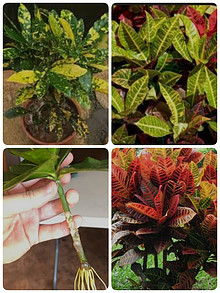
Crotons are tropical plants that come in very beautiful and attractive colors. The plant also has a frizzy texture and appearance, but trimming it is very easy. There are only three reasons you would want to prune this plant. It’s either you want to take a cutting, cut back the dead growths, or trim away the dead leaves on the plant.
The plant also has irritating sap, so you would need to put on a pair of hand gloves when pruning them. In this post, I will be showing you three easy steps you can take when pruning croton plants for better growth.
Cutting Dead Branches
Sanitize your equipment and put on a pair of gloves
To prune a croton plant, you would need pruning shears. You would also need a pair of gloves to protect your hands against the plant’s sap. You’ll also need a bottle of hand sanitizers or Isopropyl Alcohol.
After you have got the things mentioned above, dip a dry cloth into the Isopropyl Alcohol or sanitizer with you, and use it to thoroughly wipe the blades. You should also ensure you clean the pruning shears after you have finished pruning the plant.
If you do not have pruning shears, a pair of scissors can do the work.
- Cut off the dead branches and leaves from the croton
Search for leaves and branches that look dead or shriveled. If all the leaves in a branch are dead, then you need to cut out the entire branch. Ensure to cut off the branch from the part where it meets the main part of the croton.
If you cannot tell if the branch is dead or not, here are some steps that will help you in identifying one.
- Partially cut off the end of the branch and search for green
- If there are no greens, it simply means the branch is dead
- Cut out bad or diseased growths on the leaves’ stems
The leaves from a croton plant are usually bright and colorful. If you find any bad growth on the stems and veins of the leaves, use pruning shears to cut it down to the last. Ensure you disinfect the Pruning shears immediately after doing this.
- Use shears to cut off unhealthy or diseased branches.
To know if a branch is diseased, search for powdery mildew patches on it. If you find anything of such, it surely indicates a sickness of some kind. Cut at least 25cm of the branch from the disease spot; this will immediately get rid of the infection.
Some of these diseases can be a result of wet leaves, over-watering, fungal, or bacterial. So you have to look for these signs regularly on the plant. To deal with bacterial or fungal issues, you can try applying fungicide to the croton.
Shaping the leaves
- Perform hard pruning when it is early spring
You can remove dead leaves and branches or perform any form of light pruning during the summer. But ensure you delay any form of hard pruning until it is spring. Doing this will encourage new and healthy growth from the plant.
- Slowly cut off the top growth to make the plant bushier
Crotons can grow really tall. But if you are looking for something shorter and bushier, pinch or cut off the new leaves that are growing at the top of the plant. This will encourage the leaves to start growing at the base of the plant. You can try this, and it will be effective in early spring.
If you don’t want some irritating sap on your hands while doing this, ensure to put on some hand gloves. If you eventually get some of them on your hands, ensure to make use of a sanitizer or soap and water.
- Cut out at least 30% of the plant to control the shape
If your plant isn’t big enough, doing this might shock the plant and prevent its growth. Here are the steps you can use in cutting back a third of the croton.
- Clean the pruning shears or instruments to be used with sanitizers or Isopropyl Alcohol
- Cut right above the leaf or stem node of the plant
- Cut back a third of the branches

- Remember to put on your gloves to protect your hand from the plant’s sap.
Propagating the Cutting from the Plants
- Cut off about 7-10 cm from the branches of the croton plant.
If you have overgrown croton that you want to cut back, you can use the cuttings to start a new plant instead of throwing them away.
Use a pair of pruning shears to cut 7-10 cm of the branches. Ensure the branch you are cutting off has at least 3 to 5 leaves on it. Ensure you don’t cut off too much from the plant in order for it to stay healthy. Also, remember to disinfect the shears and wear hand gloves when doing this.
- Remove some leaves from the bottom of the cutting
If there are too many leaves on the cutting you have made from the croton plant, pluck off some leaves from the bottom. The leaves that should be left at the top of the cutting should be at least 3 to 5.
- Place the end of the cutting you have trimmed into a rooting hormone
Purchase a powdered Rooting hormone and pour it into a little bowl or dish. Dip the end of the cutting you have made into it. Ensure the end of the cutting is completely covered with the rooting hormone. This is because the rooting hormone will help the cutting put more roots within a short period of time.
If you don’t have a rooting hormone in your house, then you can propagate the cutting without it. The rooting hormone is actually not necessary.
- Plant the cutting in a small pot with soil
Fill up a pot or container with soil. Take a small piece of wood to make a hole where you will be planting the cutting in it; after you have finished planting the cutting, water the cutting by pouring water into the pot. Slowly pour just enough water that will completely soak the top of the soil.
Always remember to water the soil. But if the soil looks damp, you can skip the watering session for a few days.
My wrapping up
Crotons are beautiful plants with bright colors. In order to ensure the healthy growth of this plant, use the tips mentioned in this post. Thank you so much for your time reading this article. If you have any questions, please leave your comment below, and I’ll be happy to write back to you.

Nina
I like your website. It is quite informative and explains so many things you can do with the croton plant. It would be beneficial to see some pictures of where to prune the plant, maybe a before and after shot also. You have explained all the techniques very well, and it will be easy to copy when I prune my own plant.
admin
Hello Nina,
Thank you once again. I am happy to see you here, and thank you for your kind comment about Pruning the croton plant. Yes, we need to prune them to maintain their nice and beautiful shape continuously. Thank you and best wishes,
Joyce
Nina
I don’t have a croton plant, but it looks really magnificent in all the color shades of the leaves. So it was fascinating to read this description and the article How to prune a croton plant. Given that it is possible to propagate the cutting from the plants, I assume it is not such a demanding plant?
If I ever have it, I will definitely follow your tips and suggested care methods; thank you!
Friendly greeting,
Nina
admin
Hello Nina,
Good evening; thank you for your time reading my article about how to prune the croton plant. I’m glad about your comment; yes, you may use this as your guide, Nina. All the best,
Joyce
Abel
I am very methodic con no concerning pruning my croton plants. I always prune them to maintain a particular shape. There are times when I get bored of a specific condition, and I let them grow to prune them into another form. And I prune them to remove unhealthy portions of the plant or to.
admin
Hello Abel,
Thank you so much for your time and visit to my site. Thanks to that you found it helping and the guides to Pune crottons. Thanks a lot,
Joyce